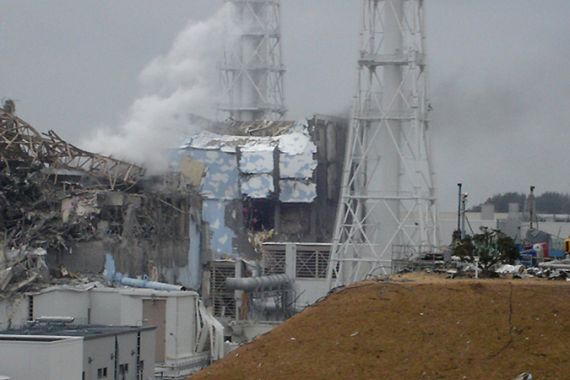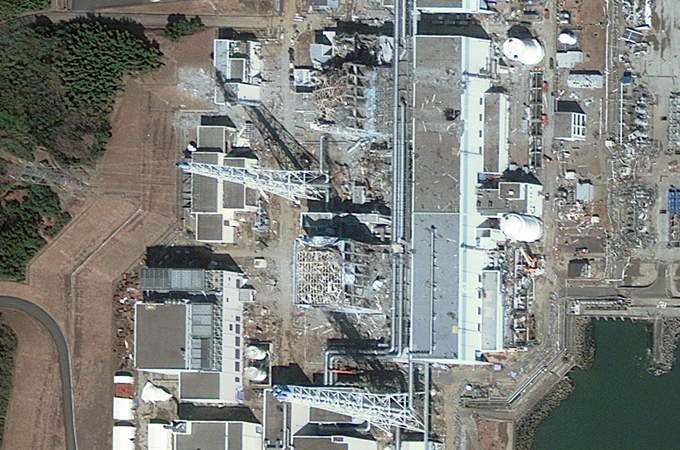Pressure stable at troubled Japan reactor
Officials rule out venting of radioactive gas into air for now at leaking Fukushima nuclear complex.

 |
| Tokyo Electric Power company officials say the pressure is relatively high, but that it has stabilised [AFP] |
The operator of Japan’s tsunami-damaged nuclear plant has backed away from plans for a venting of radioactive gas at one of the troubled reactors, saying that pressure inside has stabilised.
Officials of the Tokyo Electric Power Company (TEPCO) said on Sunday that the company decided there was no immediate need to vent the pressure at the Unit 3 reactor of the Fukushima plant.
Keep reading
list of 4 itemsTurtles swimming to extinction in Malaysia as male hatchlings feel heat
Could shipping containers be the answer to Ghana’s housing crisis?
Thousands protest against over-tourism in Spain’s Canary Islands
Hidehiko Nishiyama, safety agency official, had said earlier that rising pressure inside the reactor’s containment vessel made the release of radioactive gas necessary to prevent a more dangerous build-up.
Radiation leaked from the plant already has seeped into the food supply, with the government warning that tests of spinach and milk from areas as far as 120km away exceeded safety limits.
Tap water farther away turned up tiny amounts of radioactive iodine in Tokyo and other areas.
Caught off-guard
Amid concerns of wider contamination, a nuclear safety official said the government was caught off-guard by the accident’s severity and only belatedly realised the need to give potassium iodide to those living within 20km of the Fukushima Daiichi nuclear complex.
| LIVE BLOG |
 |
The pills help reduce the chances of thyroid cancer, one of the diseases that may develop from radiation exposure.
The official, Kazuma Yokota, said an explosion at the plant’s Unit 3 reactor last Sunday should have triggered the distribution but the order only came three days later.
“We should have made this decision and announced it sooner,” Yokota said at the emergency command centre in the city of Fukushima.
“It is true that we had not foreseen a disaster of these proportions. We had not practised or trained for something this bad. We must admit that we were not fully prepared.”
While four of Fukushima’s six nuclear reactors have been dangerously overheating since the March 11 earthquake and tsunami disrupted cooling systems, Unit 3 has proved particularly troublesome.
Though the government said on Saturday that the unit appeared to be stabilising after being doused with water, nuclear-safety officials said the efforts may not have worked.
While battling Unit 3, emergency teams used an unmanned vehicle to spray water at another at-risk reactor – Unit 4 – even as they prepared to switch power back on for the first time since problems began at the complex.
However, there was no guarantee the cooling systems would work once power was restored.
Rising toll
Japan has been struggling with an overwhelming chain of disasters prompted by the 9.0-magnitude quake. It touched off a tsunami that ravaged the northeastern coast, killing more than 8,100 people and knocking out cooling systems at the plant, prompting overheated reactors and fuel to leak radiation.
More than 12,000 people are still missing, and around 452,000 are living in shelters.
Police said an 80-year-old woman and a teenage boy were rescued from the wreckage of a house in northeastern Japan, nine days after the earthquake and tsunami.
Rescuers found the 16-year-old boy on the roof of his house in the hard-hit city of Ishinomaki, calling out for help, according to the Miyagi Prefectural Police.
The national police agency said on Sunday 8,133 people had been confirmed dead and 12,272 officially listed as missing – a total of 20,405.
The death toll has now well surpassed that of the 7.2-magnitude quake that struck the western Japanese port city of Kobe in 1995, killing 6,434 people.
The March 11 quake has become Japan’s deadliest natural disaster since the 1923 Great Kanto Earthquake, which killed more than 142,000 people.